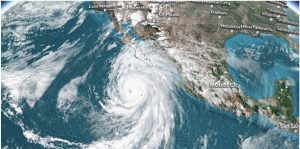Ten weather disasters in the world this year caused damages worth $150 billion, beating the cost of the previous year and reflecting a long-term impact of climate change, according to a report released on Monday.
These costly disasters killed nearly 3,500 people and forced over 13.5 million people to evacuate.
From Australia’s wildfires in January to a record number of Atlantic hurricanes through November, the cost of this year’s climate-enhanced disasters was in fact far higher because most losses were uninsured.
Also read: Thousands without power, planes delayed as storm Bella lashes France
According to the annual tally from global NGO Christian Aid, entitled “Count the cost of 2020: a year of climate breakdown”, the burden fell on poor countries.
Only 4% of economic losses from climate-impacted extreme events in low-income countries were insured, compared with 60% in high-income economies, as per the report.
“Whether floods in Asia, locusts in Africa, or storms in Europe and the Americas, climate change has continued to rage in 2020,” said Christian Aid’s climate policy lead, Kat Kramer.
Extreme weather disasters have plagued humanity long before manmade global warming began to mess with the planet’s climate system.
Also read: 6.3 magnitude earthquake rocks Philippines: USGS
But more than a century of temperature and precipitation data, along with decades of satellite data on hurricanes and sea level rise, have left no doubt that Earth’s warming surface temperature is amplifying their impact.
Massive tropical storms are now more likely to be stronger, last longer, carry more water and wander beyond their historical range.
2020’s record-breaking 30 named Atlantic hurricanes, with at least 400 fatalities and $41 billion in damages, suggest the world could see more such storms as well.
Intense summer flooding in China and India, where the monsoon season brought abnormal amounts of rainfall for the second year running, are also consistent with projections on how climate will impact precipitation.
Five of the most costly extreme weather events in 2020 were related to Asia’s unusually rainy monsoon.
Wildfires that scorched record areas in California, Australia and even Russia’s Siberian hinterland, much of it within the Arctic Circle, are also consistent with a warmer world and a predicted to get worse as temperatures climb.
The planet’s average surface temperature has gone up at least 1.1 degrees Celsius on average compared to the late 19th-century, with much of that warming occurring in the last half-century.
The 2015 Paris Agreement enjoins the world’s nations to collectively cap global warming at “well below” 2C, and even 1.5C if feasible.
A landmark report in 2018 from the UN’s IPCC climate science advisory panel showed that 1.5C is a safer threshold, but the likelihood of staying below it have grown vanishingly small, according to many experts.
If the growing frequency and intensity of natural weather disasters are consistent with modelling projections, the new field of attribution science is now able to put a number on how much more likely such an event is due to global warming.






